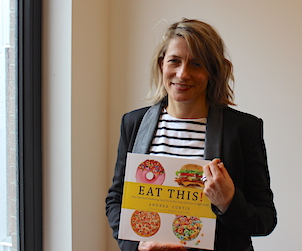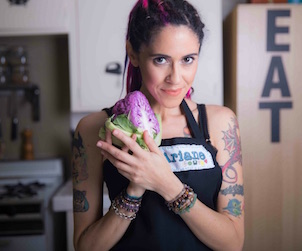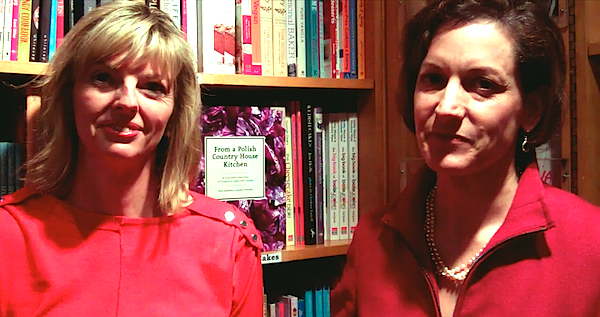Malcolm Jolley talks to author Andrea Curtis about Eat This! her book for kids about fast food marketing.
 Back in 2012 the journalist and author Andrea Curtis published a remarkable book called What’s For Lunch. It was a powerful volume that simply showed readers pictures of school children’s lunch from around the world. The message was simple: in North America we were (are) letting our kids down by feeding them empty calories and processed junk, but needn’t be the case: just look at what kids eat in France and Japan. (Interviewed her on the book in this GFR post.)
Back in 2012 the journalist and author Andrea Curtis published a remarkable book called What’s For Lunch. It was a powerful volume that simply showed readers pictures of school children’s lunch from around the world. The message was simple: in North America we were (are) letting our kids down by feeding them empty calories and processed junk, but needn’t be the case: just look at what kids eat in France and Japan. (Interviewed her on the book in this GFR post.)
Half a decade later Curtis is back with a similarly formatted book called Eat This! How Fast-Food Marketing Gets You To Buy Junk (and how to fight back). Eat This! is consistent with Curtis’ show don’t tell style. The book graphically demonstrates the ways junk food companies market to children page by page, and offers examples of times when citizen’s have pushed back. It’s a compelling and interesting book, and, I think, wonderfully dangerous. Curtis’ allies and supporters of the book include Jamie Oliver, Mark Bittman, and Real Food For Real Kids founder Lulu Cohen-Farnell, so I guess I am in good company.
I had the pleasure of interviewing Andrea Curtis, who I consider a friend, at my home recently. Our conversation about her book and fast-food marketing to children is recorded below.
This interview has been edited for clarity, style and length.
Good Food Revolution: Who is Eat This! written for?
Andrea Curtis: I think of it as a book for kids nine to twelve. It’s really visual, with lots of different bits an pieces, and it’s written for that age group. But I imagine younger kids will get access to it because of the visuals, kind of like What’s For Lunch.
Good Food Revolution: I’m glad you brought up your previous book, What’s For Lunch, that shows school lunches from all over the world, because I wondered if Eat This! was the second book in an ongoing series? I see you have a website now called andreacurtiskids.ca.
Andrea Curtis: Yes. I am doing more kids writing, and I have a ‘YA’ novel coming out this year as well. [Big Water.] But my publisher sees Eat This! as the second book in a two book series. It’s sort of like a package, where both books are the same print size, and similar cover design with the bar across the middle.
Good Food Revolution: The cover is literally very attractive. I had a bit of a panic this morning because I couldn’t find my copy. I looked all over the house wondering where I might have left it, only to discover it in one of my kids’ bedrooms.
Andrea Curtis: That’s good! Yes! That warms the cockles of my heart.
Good Food Revolution: He must have grabbed it from the study, or maybe I left it in the kitchen or something. Anyway, I suspect it was the big pink donut that got him.
Andrea Curtis: [Points to the donut, cheeseburger, pizza and Fruit Loops on the book cover.] I know. My kids are like, I like that, that, that and that. [Laughs.]
Good Food Revolution: So did you write the book to warn kids? Or help parents?
Andrea Curtis: I realized how powerful and effective the marketing to kids is when my son was in junior kindergarten. His teacher was doing a pre-literacy project, and the kids to identify the brands that they knew by sight. Then they cut out the logos and advertisements, put them on a poster and hung it in the hallway. I would say between 85% to 90% of the ads were for fast-food or sugary drinks. I thought, these are kids who can’t read, and they are identifying things by the environment they live in and the environment they live in is full of fast-food marketing. I started to think, wow, this is an intense process.
Good Food Revolution: I’m going to assume that your son and his classmates were from pretty solid middle class backgrounds – had parents who were educated professionals, and so on.
Andrea Curtis: Yeah, just regular Canadian school kids in a local public school. They’re all inundated with this marketing. So, after that I started working on the book What’s For Lunch. One of the most surprising things I discovered, when I looked at what school children ate for lunch around the world, was how much fast food marketing has infiltrated the schools in North America. Selling Domino’s pizza in the cafeteria is just beginning. In the U.S. there are school buses that are lacquered with ads. And, of course, there are the vending machines, and the scoreboards, and the signs outside of schools. It’s everywhere, and I stared to wonder about what this does to kids and how it works.
Good Food Revolution: It’s completely normalized.
Andrea Curtis: It’s our environment and we’ve accepted it without asking how much marketing is a part of our lives. It’s almost like marketing is our culture, and for kids even more so.
Good Food Revolution: I don’t think you can argue with money, and these companies are spending a lot of money to sell this stuff to our kids. But I have also been a marketer, and know most of them are actually kind of scared about what they’re doing and whether it will work or not, whether their product will take off or fail. We think of these people as sort of evil geniuses, but most of the time they’re worried about making a bottom line or losing market share. There’s a question in here somewhere… I guess I am trying to get at how do you see this book working, if it’s successful and does what you want it to?
Andrea Curtis: I see Eat This! as an exercise in media literacy and food literacy combined. Because there is so much marketing of fast food and sugary drinks to kids it’s a great way to talk about how marketing works. So, I see it as a way to offer kids tools to decode what they’re bombarded with. All the curriculum for this age group, nine to twelve, asks them to be taught media literacy. Some teachers don’t know how to do it. Many teachers do, but there are very few texts for them to work with. This book offers kids something they see all the time, and they know it way better than we do, by the way. They may not understand what the marketing is doing, and its consequences, so I hope this book can be a kind of tool that gives kids the ability to recognize what they’re being sold and ask the questions they need to be able to ask. I don’t think the book is going to, on its own, change the world, but I do think that as kids recognize what’s being sold to them, and how it’s being done, they may start to say (and I hope they will), “I’m being tricked!”
You said you were in marketing, and I don’t know how many products you sold to kids, but there is a difference between selling things to cognizant adults who should have the ability to make informed choices and children. The evidence is very clear that under the age of eight, kids cannot discern the difference between information and marketing messaging. After the age eight, up to about the age of twelve, they understand the difference, but they’re not critical. And even after that, with the more and more understanding we have of the teenage brain, the more we realize that we also have to support teenagers to understand what’s being sold to them. As parents, as teachers, as advocates for kids we have a responsibility to protect them.
Good Food Revolution: It doesn’t seem like we’ve been doing a very good job of that.
Andrea Curtis: There is absolutely no question that we have a diet generated health crisis. One in three Canadian kids are overweight or obese. Diabetes Canada says that we are going to see a 44% increase in Canadians with the disease before 2025.We also know that heart disease and some kinds of cancers are diet related. We have a real crisis and a responsibility to protect kids. Now fast-food marketing and sugary drinks advertising may not be the only reasons for this crisis, but we’ve got a food environment that is toxic and really unhealthy so we have to help kids and protect them with legislation that limits marketing to kids.
Good Food Revolution: Like in Quebec?
Andrea Curtis: Right, like in Quebec. I don’t know how much you have been following this but Senator Nancy Green Raine, the former Olympic skiing champion, introduced a bill in the Senate called The Child Health Protection Act. It passed in the Senate and is before the House and is part of the Liberal government’s Healthy Eating Strategy and it restricts marketing to kids. It’s in second reading and before committee. The original bill restricted marketing to kids under 17, it will probably be clawed back to under 13, and there will be some exemptions. There is a lobby to protect things like Timbits Hockey and other fast food sponsored kids’ sports. It’s proposed that the exemptions would be reviewed after five years, though, because some people think that marketing fast food in kids athletics creates a bit of a tension.
Good Food Revolution: Hey, at least those kids are exercising.
Andrea Curtis: Well, sure, but…
Good Food Revolution: In all seriousness, we know that these are dangerous products, and we’ve discussed the persuasiveness of the marketing and advertising messages, but the products themselves are a problem. Many of them are literally engineered to be addictive. I have a kid who, if he were allowed or had access, would probably drink a dozen soda pops a day without thinking much of it.
Andrea Curtis: A quarter of Canadian kids aged 9 to 15 drink at least one sugary drink every day. The World Health Organizations recommends a limit of something like 13 teaspoons of sugar a day. That’s the maximum. One single can of pop contains ten, and a slushy is 24 teaspoons of sugar.
Good Food Revolution: Eat This! has really just come out, so maybe this isn’t a fair question, but… Are you getting uptake? Are teachers interested in it? How is it being received?
Andrea Curtis: Yeah I think so. I hope parents use it to talk about this with their kids. And kids seem to be interested in it for its cover. But I really do think that teachers and librarians are going to find it to be a really useful tool. So, yeah, it’s just out but I am already hearing from teachers who are using it. I heard from one who was using it before the Black Panther movie came out last weekend, and she asked her kids to count how many examples of fast food marketing they could find related to it. And then she said, if you find 20 or more examples, you’ll get a Timbit treat. [Laughs.] The teacher knew exactly what she was doing. The kids, either because they didn’t want to threaten the possibility of getting a Timbit, or because they are so accustomed to being bribed with fast-food, even in schools that teach media literacy, didn’t raise the issue at all. They didn’t question it, and one kid I think came up with 45 different examples. I imagine they were pretty disappointed when the teacher pointed out how they were duped and didn’t have any Timbits.
Good Food Revolution: The way Eat This! works is very much ‘show don’t tell’, right? You basically just show kids the various ways companies market to them and provide examples.
Andrea Curtis: In my experience you get very little impact from shaming people, or blaming them, or acting self-righteous. I say in the back of the book, where there’s a mini interview with me, that marketing has worked on me too. And it works on my own children. I was affected, as a teenager, but the ubiquity and marketing of diet pop. I must have had about seven diet sodas a day in high school. That’s a lot of aspartame.
Good Food Revolution: I forgot about that. We would have cases of Diet Pepsi in our house because we thought it was ‘healthy’.
Andrea Curtis: Yes, exactly! [Laughs.] In the same way, I am very sure that in 20 years we are going to look back at what our kids are eating and drinking and say, what were we thinking? Why didn’t we protect kids more? Our food environment is making our kids sick.
Good Food Revolution: And we know that if you start your life in a not great way, it’s that much harder to change it as an adult.
Andrea Curtis: Yes, and marketers know it too. That’s why they want to get those young kids. The story I told about the kids in the kindergarten class: that’s a success. The earlier you get people interested in your brand, the longer the loyalty lasts. And, you know, even adults are attracted to those spokes-characters that they knew as kids.
Good Food Revolution: I can remember reading about this nearly 20 years ago in Eric Schlosser’s Fast Food Nation. In your research, have you found any evidence that things are improving at all? Is The Resistance winning any battles?
Andrea Curtis: The resistance to fast-food marketing is definitely picking up speed. We know that since 1980 Quebec has had a ban on advertising to children and it’s had a tremendous impact: lower rates of overweight and obesity. Kids in Quebec eat more fruit and vegetables and less junk food. So it will be really interesting if Bill S-228 does pass and the federal government can make the restrictions stick. But the thing that’s really changed in the last 20 years is the media. Hugely. Digital marketing is everything now. Sure, there’s still TV and movies, product placement and billboards, point of sale at the grocery stores and marketing at the schools, but digital is unbelievable. It changes all the time because people’s engagement with digital media changes all the time. Even in the process of writing this book, media would change and I would say, we have to add Pokemon Go! We have to add Snapchat filters! There would be something new all the time. So, it’s morphing and finding new ways to marker fast-food to kids.
Good Food Revolution: Oh man. And of course it’s not happening on the living room TV. Media is now a very private experience, so it’s very hard for parents to know what their kids are watching, right? It’s also not really regulated.
Andrea Curtis: And it’s free, too. So, your kid will download an app where they play a birdie game that follows a sugary cereal. And when you win a prize you give them your email address so they can send you a coupon. The SnapChat filter thing is also an incredible marketing tool. If you go into a fast-food restaurant you can take a selfie of yourself wearing a crown and a bunch of fries going into your mouth and then you send it to your friends, so you get to become a brand ambassador. They’ve made it fun, easy and part of the culture so you don’t even question it. And that’s all I am really asking of kids: that they question it. How does it work where you’re working for free for a corporation that is making millions off of your ill health? How does that make you feel? I think it’s a question that kids and adults should be asking.
Andrea Curtis keeps a website at andreacurtiskids.ca.








